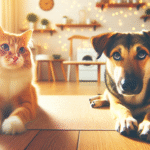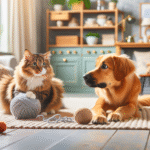Keep Your Dog Safe and Calm This Halloween: A Complete, Trainer-Backed Guide for a Stress-Free Night
Halloween can be magical for humans and messy for dogs. Strange masks change the shape of familiar faces, doorbells ring relentlessly, excited kids move unpredictably, and bowls of candy suddenly appear at muzzle height. Put it all together and even the most easygoing dog can feel overwhelmed. The good news: with a little planning, you can protect your dog from hazards and help them stay calm from first costume parade to last porch light.
This guide combines practical advice from training pros and veterinarians into one clear plan you can follow. You will learn why Halloween is uniquely triggering for dogs, how to prep in the days beforehand, what to do the day of, how to manage costumes and visitors, and what to avoid (think chocolate, xylitol, raisins, dry ice, and more). You will also get step-by-step protocols for the doorbell rush, trick-or-treat walks, anxiety management, and what to do in an emergency. Start early, follow the plan, and you will give your dog the gift of a safe, boring, blissfully uneventful Halloween.
Why Halloween Can Be Scary for Dogs
Dogs are experts at patterns. Halloween breaks the rules. The neighborhood looks and smells different, nighttime activity spikes, and the door opens and closes more than it does all year. Add costumes, masks, capes, props, flashing lights, and booming sounds, and the brain’s “threat detector” can flip to high alert. Even confident dogs may struggle to interpret altered silhouettes, moving decorations, and people who don’t “walk or talk” like people usually do.
Common stressors include:
- Repeated doorbell rings and rapid knocks
- Costumes that hide faces or change outlines, especially masks and hats
- Loud noises, shrieks, spooky music, and fireworks
- New smells from makeup, fog machines, glow sticks, and scented décor
- Unpredictable movements from groups of kids and unfamiliar adults
- Darkness and flashing lights that make it harder to read the environment
- Shifts in routine that disrupt mealtimes, walks, and sleep
When you anticipate the triggers, you can plan for them. That’s the heart of a peaceful Halloween.
A 7–10 Day Prep Plan to Build Calm Before the Chaos
If Halloween is a week away, you still have time to make a huge difference. Spend a few minutes each day on these bite-sized exercises:
- Doorbell desensitization: Play a recorded doorbell sound at low volume. Each time it rings, calmly scatter a handful of kibble or treats on the floor. Repeat 5–10 times per session, a couple of times a day. Gradually raise the volume over several sessions. The goal: doorbell equals “treat confetti.”
- “Place” or “Go to Mat” training: Teach your dog to lie down on a bed or mat while you move around and open the door. Reward generously for staying put. This becomes your go-to station during trick-or-treat hours.
- Sound acclimation: Quietly play Halloween soundscapes (door knocks, laughter, distant fireworks) while feeding a meal or a chew. Keep volume low enough that your dog barely notices, then very slowly increase over days.
- Costume preview: Let your dog sniff costume pieces laid flat on the floor. Pair each look with treats. Put on your hat or cape for 2–3 seconds, remove it, and toss a treat. Repeat in tiny steps until your dog is relaxed with you wearing the full outfit.
- Sanctuary conditioning: Choose a quiet room and build a positive association. Feed meals there, play soft music, and deliver chews or stuffed toys. On Halloween night, this becomes the safe space.
- Handling practice: Gently practice putting on a harness, reflective gear, or a simple bandana. Treat frequently and keep sessions short.
- Relaxation on cue: Reward calm, settled behavior any time you catch it. The more you reinforce “chill,” the more you’ll see it.
Day-Of Energy Management: Tire the Brain, Not Just the Body
One of the simplest ways to take the edge off Halloween jitters is to provide healthy outlets before the evening rush. Think “brain tired” as much as “body tired.”
- Morning sniff walk: A long, unhurried sniffari lowers stress naturally. Let your dog lead with their nose.
- Enrichment session: Scatter feed in the yard, hide treats in boxes, or offer a snuffle mat. Ten minutes of nose work can be more calming than a 30-minute jog.
- Short training games: A few reps of “sit, down, touch, spin” mixed with rewards builds confidence.
- Midday nap: Protect rest so your dog isn’t already fatigued when the excitement starts.
Wrap up all exercise and outdoor time at least an hour before trick-or-treaters arrive so your dog has a chance to settle.
Set Up a Safe Room Before Dusk
Management is your best friend on Halloween. Create a comfortable sanctuary where your dog can ride out the commotion without constant exposure to triggers.
- Choose the right space: A quiet interior room or bedroom works best. Close curtains to block visual stimuli.
- Sound buffer: Use white noise, a fan, or soft music to dampen doorbell rings and outdoor chatter.
- Comfort supplies: Provide a cozy bed, water, long-lasting chews, and favorite toys. Consider a frozen food puzzle for sustained focus.
- Safety barrier: Use a baby gate or closed door instead of relying on verbal cues during peak door traffic.
- Soothing aids: Talk with your vet ahead of time about calming tools. Options may include pheromone diffusers, anxiety wraps, or prescribed medications for noise-sensitive dogs.
Introduce the room beforehand so it feels familiar and rewarding by the time the first costume hits your steps.
Front-Door Protocol: A Step-by-Step Plan
Turn door chaos into a controlled routine. Decide who will handle the dog and who will handle the door, or plan for a no-door duty night if you are solo.
- Minimize triggers: Place a note on the door asking visitors to knock softly once. Keep the porch light consistent to avoid strobing effects.
- Pre-station treats: Keep a jar of high-value treats by your dog’s mat. Doorbell chimes? Toss treats on the mat. Reward even if your dog barks; you are paying for returning to “place.”
- Leash insurance: Use a lightweight leash on your dog in the house during peak hours to prevent door dashing.
- Block the view: Position your dog’s mat away from the direct line of sight to the door to reduce arousal.
- Short shifts: If possible, rotate family members through “dog duty” so no one gets overwhelmed.
If your dog finds any door activity too intense, skip answering entirely. Place candy outside with a friendly sign and spend the evening cuddled up in the safe room together.
Costume Comfort: A Safety Checklist
Dressing up your dog can be adorable, but safety and comfort come first. Not all dogs enjoy wearing costumes, and forcing it can create stress or even injury.
- Fit and freedom: Your dog should move, see, hear, pant, and potty normally. Avoid anything that compresses the chest or neck.
- No dangling parts: Loose ribbons, buttons, or small accessories can be choking hazards if chewed off.
- Watch body language: Yawning, pawing at the costume, pinned ears, whale eye, freezing, or slinking away are signs to remove it.
- Short dress rehearsals: Practice in 10–30 second sessions days before Halloween, pairing with treats and praise.
- Choose a simple alternative: If your dog dislikes costumes, opt for a festive bandana, bow tie, or collar charm.
- Reflective touches: Add reflective tape or a lit collar if you’ll be out at dusk.
When in doubt, skip the costume. A happy, relaxed dog is the best accessory.
ID, Microchips, and Lost-Dog Readiness
With doors opening repeatedly and kids flooding the sidewalks, even well-trained dogs can slip out. Prepare as if a mistake could happen—because on Halloween, it can.
- Double-check ID: Ensure your dog wears a snug collar with a legible tag that includes your mobile number. Use the two-finger rule for fit.
- Microchip matters: Confirm your chip is registered and your contact info is current. Many veterinarians and shelters will scan a chip for free.
- Harness up: Use a well-fitted harness and standard leash (not a retractable) for any outings.
- Current photo: Take a clear, up-to-date photo on Halloween morning to share quickly if needed.
- If your dog gets loose: Do not chase. Crouch low, turn sideways, use a cheerful voice, and toss very high-value treats. Open your car door if your dog likes car rides.
Preparation turns a potential emergency into an easily solved mishap.
Toxic Treats: What to Keep Out of Paws’ Reach
Seasonal temptations are everywhere on Halloween. Some are more dangerous than others. Keep all candy and human treats off the floor, in closed containers, and away from curious noses. Here are the biggest risks:
- Chocolate: Dark and baking chocolate contain higher levels of methylxanthines that can cause vomiting, diarrhea, restlessness, rapid heart rate, and in severe cases, seizures. Severity depends on the amount and type consumed. Store all chocolate high and sealed.
- Xylitol: This sugar substitute (often in sugar-free gum, candies, mints, and even some peanut butters) can cause a rapid drop in blood sugar and, at higher doses, liver failure. Even small amounts can be dangerous. Assume any “sugar-free” product is off-limits.
- Raisins, grapes, currants: These can trigger kidney injury in some dogs, even in small quantities. Keep trail mix and mini-boxes of raisins locked down.
- Alcohol: Spiked punches, beer, and cocktails can cause vomiting, diarrhea, tremors, central nervous system depression, and, in severe cases, coma. Keep glasses and bottles out of reach.
- Cannabis edibles: THC-laced candies or baked goods are especially risky for dogs due to chocolate, xylitol, and THC combined. Ingestion may cause disorientation, dribbling urine, ataxia, and sensitivity to stimuli. Always store securely.
- Wrappers and sticks: Foils, plastic wrappers, and lollipop sticks can cause gastrointestinal obstructions or lacerations. Pets may eat these while raiding candy.
If you suspect your dog ate something dangerous, act quickly. Call your veterinarian, an emergency clinic, or an animal poison hotline. Keep the candy wrapper or package to share exact ingredients and amounts.
Decor Dangers: Flames, Fog, Batteries, and Pumpkins
Halloween décor is designed to surprise, but surprises and pets don’t mix. Survey your home and yard for the following:
- Open flames: Candles and jack-o’-lanterns can burn noses and paws or start fires if knocked over. Use flameless LED candles instead.
- Dry ice and fog machines: Dry ice can cause oral irritation, lethargy, weakness, nausea, and vomiting if chewed or ingested. Keep it completely inaccessible and never in bowls or cups pets can reach.
- Glow sticks and glow jewelry: The liquid inside tastes bitter and can prompt drooling and vomiting if punctured. Keep these away from chewers.
- Fake cobwebs and string lights: Entanglement risks are real, and cords can be chewed. Secure cords and avoid hanging webbing near pet paths.
- Button batteries: Ingested batteries can cause severe burns in the esophagus or stomach within hours. Keep battery-operated decorations secured and out of reach.
- Rotting pumpkins: Moldy gourds can cause gastrointestinal upset. Dispose of soft, decaying pumpkins promptly and store fresh ones where your dog can’t snack.
- Essential oils and potpourri: Concentrated oils can be irritating or toxic. Avoid diffusing strong scents in the safe room.
Walk through your home at your dog’s eye level to spot hazards you might otherwise miss.
Should You Take Your Dog Trick-or-Treating?
Many dogs would rather stay home. Between costumes, crowds, and constant motion, even social dogs can find trick-or-treating overstimulating. If you do bring your dog, set them up for success:
- Know your dog: Only bring dogs who are confident with crowds, calm around kids, and comfortable with costumes.
- Go early and go short: Choose a quieter time and a shorter route. Have an exit plan if your dog looks uneasy.
- Gear up for safety: Use a secure harness, a fixed-length leash, reflective gear, and a lit collar.
- Practice space: Keep three to six feet from other dogs and people unless they ask to say hi and your dog consents.
- Watch the ground: Scan for dropped candy and wrappers. Consider a basket muzzle for enthusiastic scavengers who are muzzle-trained and relaxed wearing it.
If you’re unsure, skip the outing. Your dog won’t miss what they never see, and you’ll avoid unnecessary stress.
Reading Your Dog’s Body Language
Dogs communicate discomfort long before they bark or bite. Teach everyone in your household to look for early stress signals:
- Subtle signs: Lip licking (without food), yawning, turning away, avoiding eye contact, slow blinking, shaking off, lifting a paw, or sudden scratching
- Moderate signs: Pacing, restlessness, whining, pinned ears, tucked tail, crouching, or hiding
- Escalation: Growling, hard stare, showing teeth, snapping
At the first sign of discomfort, remove your dog from the situation, lower the intensity, and offer calm support—not pressure—to interact.
Noise Sensitivity: Calming Strategies That Work
Noises are a top trigger on Halloween. Combine several approaches for the best results:
- Sound insulation: Close windows, draw curtains, and use white noise or calming music in the safe room.
- Calming pressure: Some dogs relax with a snug-fitting anxiety wrap.
- Chewing and licking: Long-lasting chews and stuffed toys promote licking and chewing, which can help self-soothe.
- Veterinary support: If your dog struggles with noise year-round, ask your vet about supplements or medications. Avoid sedatives that immobilize without reducing anxiety unless your veterinarian specifically recommends them.
Start noise relief measures before peak activity rather than waiting until your dog is already distressed.
Multi-Dog Homes and House Guests
Halloween can amplify normal household friction. If you have multiple pets or company visiting, keep things smooth with extra structure:
- Separate spaces: Give each dog their own rest area, especially if resources like chews are involved.
- Managed greetings: No pet should be forced to interact with guests or kids. Empower them to opt out.
- Feeding and chews: Offer high-value chews only in separate, gated areas to prevent conflict.
Proactive management prevents scuffles and lets each animal decompress at their own pace.
Aftercare: Decompress and Reset
Once the porch light goes off, help your dog come back to baseline:
- Quiet time: Keep the house calm for an hour after trick-or-treating ends.
- Sniff reset: If it’s not too late or noisy, a short sniff walk can release lingering stress.
- Hydration and bathroom break: Offer fresh water and a calm potty break.
- Audit the environment: Sweep for dropped candy or wrappers before letting your dog roam again.
Document what worked and what didn’t so next year’s plan is even smoother.
What To Do If Your Dog Ingests Something Dangerous
Quick action matters. If you suspect your dog ate chocolate, xylitol, raisins, alcohol, or anything questionable:
- Stay calm and gather information: Note what was eaten, how much, and when. Keep packages and ingredient lists.
- Call for professional help: Contact your veterinarian, the nearest emergency clinic, or an animal poison hotline for immediate guidance.
- Do not induce vomiting unless instructed: Certain substances and situations make this dangerous. Only proceed with a veterinarian’s direction.
- Monitor symptoms: Watch for vomiting, diarrhea, lethargy, tremors, restlessness, weakness, or changes in behavior. Seek care promptly.
When in doubt, err on the side of calling. Timely advice can prevent complications.
Special Considerations: Puppies, Seniors, and Sensitive Dogs
Some dogs need extra care on Halloween, including puppies, elderly dogs, and those with medical or behavioral challenges.
- Puppies: Prioritize positive experiences over exposure. Keep introductions brief and upbeat, and avoid overwhelming scenes.
- Seniors: Provide cushioned bedding in the quietest room, minimize stairs, and keep routines steady to reduce confusion or anxiety.
- Noise-sensitive or anxious dogs: Plan full sanctuary mode. Talk to your vet in advance about medical support options and stick to a calm, predictable evening.
The best “training” for sensitive dogs on Halloween is thoughtful management and kindness.
Trainer’s Toolkit: Simple Games That Lower Arousal
Keep a few low-effort activities ready to redirect and relax your dog when excitement spikes:
- Scatter feeding: Toss a small handful of kibble in the safe room for a quick sniff-and-search break.
- Catch-the-treat: Gently toss treats one at a time for your dog to catch, which builds focus and fun without revving them up.
- Hand target (“touch”): Hold your hand out and cue “touch.” Reward nose-to-hand contact. This resets attention and builds confidence.
- Settle on mat: Cue “place,” reward, then slowly lengthen calm time on the mat with intermittent treats.
Keep sessions short and end while your dog is still successful. The goal is calm engagement, not high energy.
Weather and Visibility: The Practical Stuff
Even if your Halloween is quiet, don’t skip basic safety:
- Visibility: Use reflective collars, harnesses, and leash accents for dusk and dark walks.
- Footing: Watch for slippery leaves and wet pavement. Avoid yards with hidden wires or decorations that can snag paws.
- Temperature: In warm climates, avoid overdressing and limit exertion. Offer water before and after outings.
Thoughtful prep prevents avoidable slips, trips, and discomfort.
Quick-Reference Halloween Safety Checklist
- One week out: Start doorbell desensitization and mat training; create and reward time in a safe room; preview costumes.
- Two to three days out: Stock calming chews, puzzle feeders, and high-value treats; confirm ID tags and microchip registration.
- Morning of: Take a relaxed sniff walk; offer enrichment games; protect nap time.
- Afternoon: Dog-proof candy and décor; set up white noise and gates; pre-stage treats by the door and mat.
- Evening: Keep your dog in the safe room or on a leash in the house; reinforce “place”; manage the door; stick to simple routines.
- After: Sweep for dropped candy and wrappers; provide quiet decompression time; note wins and improvements for next year.
Keep this checklist on your fridge. A calm plan beats a reactive scramble every time.
FAQ: Fast Answers to Common Halloween Questions
Is it okay to give my dog a tiny piece of chocolate? No. Chocolate can be toxic, particularly dark and baking chocolate. There are plenty of dog-safe treat options that avoid the risk entirely.
My dog loves people—why is Halloween different? Costumes, masks, and erratic movement make it harder for dogs to read social cues. Even social butterflies can feel conflicted when familiar rules change.
What calming aids really help? A layered approach works best: safe room, white noise, enrichment chews, and—where appropriate—vet-recommended supplements or medications. Avoid relying on sedatives without veterinary guidance.
Can I train my dog to love the doorbell in a week? You can make meaningful progress with daily, low-stress practice, but go at your dog’s pace. If they’re sensitive, focus on management first and continue training after Halloween.
Is a costume ever “worth it” if my dog dislikes it? No. Choose comfort over photos. A simple festive bandana keeps your dog “in costume” without the stress.
The Big Picture: Protect, Predict, and Pair With Good Things
Halloween success boils down to three principles. First, protect your dog from hazards and overwhelm with management: safe rooms, gates, leashes, and secure storage. Second, predict where your dog might struggle and reduce those triggers ahead of time: block line-of-sight to the door, turn down the lights, and control the flow of visitors. Third, pair spooky stuff with good stuff: doorbell rings unlock treat rain, quiet time comes with a chew, and calm behavior earns praise. These habits don’t just help on Halloween; they build resilience for every noisy holiday to come.
With a little foresight, you can make Halloween uneventful for your dog—and that’s the goal. An uneventful night is a safe night. Close the curtains, queue the white noise, prep a chew, and enjoy the cozy indoor glow while the ghosts and goblins pass by outside. Your dog will thank you with a gentle sigh and a happy curl into the bed you thoughtfully prepared.
Your Turn
What is the one change you plan to make this year to help your dog feel safer and calmer on Halloween night?







